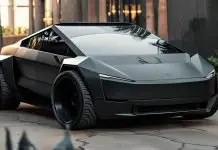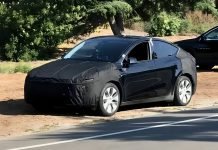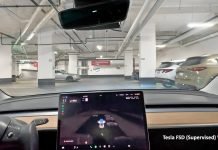Tesla FSD (Full Self Driving) is a hot topic in the autonomous vehicle industry right now, and not always for the right reasons. While the initial reactions to the October launch of the FSD were quite impressive, there have been a few bugs as well. Overall, however, the feeling about the new software from Tesla is leaning towards the positive side. There are 30-minute FSD drives, clips of driving around on California’s famous Lombard Street, and also the toughest night-time test yet. But it has managed to overcome these challenges without any incident.
But the entire point of a beta program is to try out different things, use the software in different situations, and see how it reacts. This also helps the system learn on its own, through the tons of data it is collecting. And so, the customers who have received the beta program of the FSD try to take the system into different situations and see how it responds. One such customer, Chuck Cook, carried out a test on his Model Y and took it to YouTube to post the results. One point to be noted is that Chuck has version 8.2 of the FSD Beta program, not the latest 8.3.
The Test
The idea was simple. Stop the car into the leftmost lane for taking a turn off a highway. Engage Autopilot, and let the car take the turn while understanding the speed and frequency of the oncoming traffic. He carried out a test earlier, which involved going across the traffic from the rightmost lane to take a left turn. That meant the car had to rely on the B-pillar camera on the sides. But this test should be slightly easier, according to Chuck. The front-facing camera would get a better view of oncoming traffic than the side-facing camera would. The aim of the test was to understand how the car would commit to a gap in the oncoming traffic, how quickly it would accelerate through the gap, and how well it would time the ‘committing to a gap’ part.
The video consists of three different views – a front-facing view from inside the car, a view of the screen to understand the car’s detection capabilities, and a bird’s eye drone view. Chuck got nine takes of this test and got mixed results. The highway has a speed limit of 45 mph, but Chuck reckons that cars normally drive faster than that.
The Results – Negative Ones First
Chuck decided to carry out nine different takes of this take, but he could’ve gotten a lot more had the battery of his drone cooperated. Here’s the list of everything that happened in each take where something went wrong.
1st take: Chuck engaged the Autopilot, and the car crept to the edge of the turn. However, it committed to a gap too early and did not judge the speed of the incoming cars correctly. The gap could have been breached had it been quick, but even then, Chuck reckons that the incoming cars would have had to brake.
RESULT – Chuck had to intervene.
2nd take: Once again, the same thing happened, as the car could not predict the gap properly. This meant that it committed to taking the gap too late and probably would have crashed.
RESULT – Chuck had to intervene.
4th take: There was a gap after a group of three cars, which were running in the second and third lanes. The car crept up into the first lane but tried taking the gap too early, and instead of creeping entirely through the first lane, it accelerated quickly.
RESULT – Chuck had to intervene.
5th take: Once again, there was a gap after a small group of cars. But the car decides to take the gap too early, instead of creeping slowly.
RESULT – Chuck had to intervene.
9th take: engaged while rolling, commits too early
RESULT – Chuck had to intervene.
The Results – Positive Takes
3rd take: This time, there was a lot of incoming traffic. A few large trucks and semi-trucks were coming in at a high speed, and the car waited them out. It spotted a gap after one such semi-truck and goes through nicely.
RESULT – FSD works nicely.
6th take: This time, there was a large gap between two sets of cars, and the Model Y takes the gap nicely.
RESULT – FSD works nicely.
7th take: There was quite a bit of traffic coming in. The frequency and speed of the vehicles meant that some patience was required. This time, the car waits nicely before committing to a gap and makes the turn successfully.
RESULT – FSD works nicely.
8th take: There was a steering wheel glitch when Chuck engaged the Autopilot. The wheel had turned 180 degrees and wouldn’t budge even though the route required it to go straight a few metres. Finally, after Chuck tapped the accelerator a little, it straightened, and the car moved forward. This time, it got an easy gap and turned hassle-free.
RESULT – FSD works nicely.
You can watch the entire video here:
Conclusion
It is kind of worrying that five out of the nine takes required Chuck to intervene. Taking a left turn through oncoming traffic is kind of a normal situation that any vehicle may encounter during a daily drive. While the vehicle is able to drive through the gaps properly, it did not get the timing right on most attempts. Sometimes it seemed too hesitant to start taking the turn, while it seemed in too much of a hurry on other occasions.
There were a couple of attempts when the car waited patiently before taking an easy gap. But the percentage of these attempts was quite low. Another issue was that the system wasn’t able to detect all vehicles that were driving past. Some people mentioned that there should be a beep or tone played when the vehicle is committing to a turn. That way, the driver is alert and can intervene whenever necessary. Because quite frankly, watching Chuck intervene was stressful – it was a high-pressure situation. An inexperienced driver may not be as quick to intervene.
It is quite clear that the FSD suite is still some distance off from being deemed safe. Many people believe that Tesla’s approach of using only camera vision is wrong. LiDAR (Light Detection and Ranging) needs to be included as well. Elon Musk, of course, has always been against the use of LiDAR in autonomous vehicles. Many people also believe that the current hardware is good only for reaching Level 2, or at the most, Level 3 of vehicle autonomy. Moving forward, Tesla will have to upgrade to better detection technologies than camera vision.


















